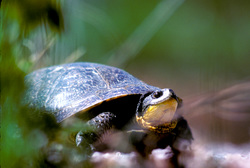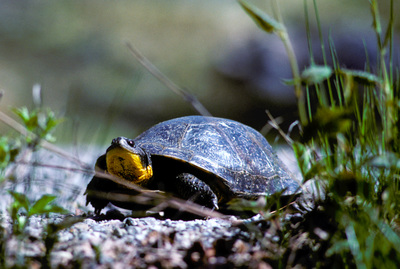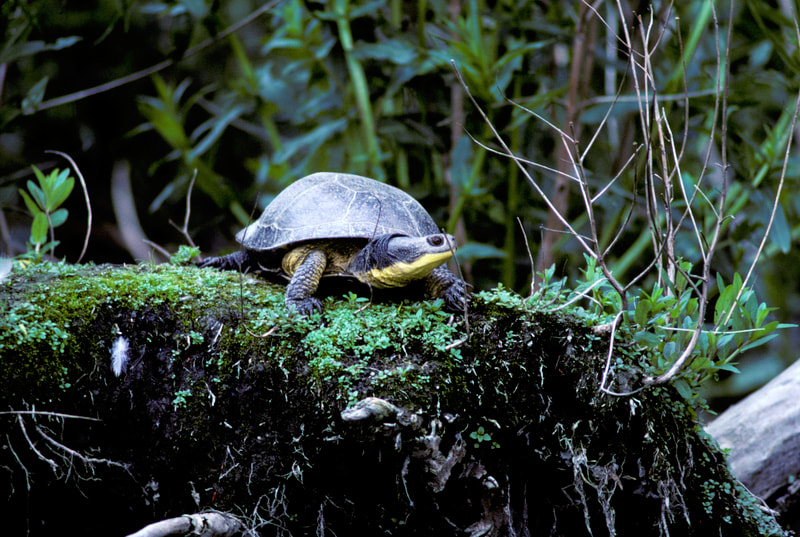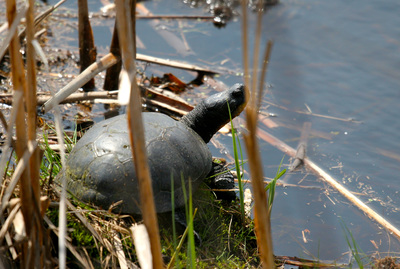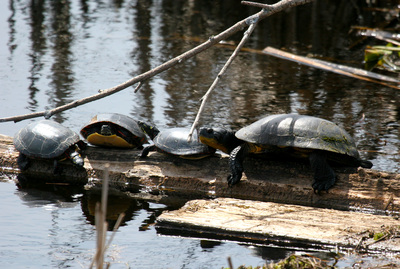Blanding's TurtleBlanding’s Turtle ((Emydoidea blandingii)
A turtle is a turtle is a turtle…or is it? Anglers likely encounter turtles when they are fishing most streams, rivers and small lakes throughout North America. They are easy to overlook but if some attention is paid to them they can prove to be rewarding moments. In Southern Ontario the majority of turtles seen will be Midland Painted turtles (Chrysemys picta marginata). The odd encounter with a snapping turtle (Chelydra serpentina) might also happen. But sometimes if the angler is lucky and alert he or she may come across a real rarity, a Blanding’s turtle. Identifying this species is fairly easy. It is the only North American turtle with a solid, bright yellow neck. Even the domed shell is flecked with yellow spots although these do fade with age. Adult Blanding’s are larger than adult Painted turtle with a carapace (the upper part of the “shell” that can be up to 28 centimeters long (10.25 inches). A Painted turtle in comparison grows to a maximum length of 19.5 cm (7 inches). On the other hand a snapping turtle can reach almost double the size of the Blanding’s. Blanding’s turtles are found from Southern Ontario and in the Great Lake’s regions of the US. In Ontario and New York State they are a threatened species. In much of the rest of their US range they listed as Endangered. Their numbers are declining due to habitat loss. They like shallow lakes, ponds and wetlands with clean water and mucky bottoms. They hibernate in the soft bottoms of lakes and marshes but their overwintering sited may be several kilometers from their summer feeding and nesting sites. This species makes the longest overland migration of any of our turtle species and has been known to travel several kilometers between the two locations (although the average distance is about a kilometer). Because of the requirement for two distinct habitats the home range for this species tends to be quite large. They are a long-lived species and females do not reach breeding age until they are 14 or 15 years old. They can live to be over 75. As with many other reptiles the sex of the young is determined by the incubation temperature of the eggs. Eggs incubated at temperatures between 22°C and 28°C will result in males, while temperatures between 30°C and 32°C produce females. Nests are excavated in a sunny area with good drainage. Up to 22 eggs may be laid in late May or early June. They will hatch in the fall. Females do not nest every year. In some studies they have been found to nest every two to three years. Nest predation by coyotes, fox and raccoons destroys many nests. Herons and large fish will eat the hatchlings. Blanding’s turtles are omnivores. They feed on crayfish, insects, fish, frogs and a variety of plant material. They will also scavenge carrion. However, unlike most turtles, Blanding’s turtles will also feed on land where worms and berries may become part of their diet. Although habitat loss is the major threat to this species many are also killed during their spring and fall migrations as they cross roads. Because they are one of the “prettier” turtles they are also captured by people and kept as pets. This effectively removes them from the breeding population. It is illegal to keep them as pets. Like the Painted turtle, Blanding’s turtles do not appear to age once they reach 20 years or so. In fact the females become more fertile as they age and they lay more eggs. Encountering one of these reptiles on an outing is a rare experience and you are urged to report the sighting to your local Conservation Officer or the Ministry of Natural Resources. No one knows how many of these turtles remain in the wild and every bit of data helps paint a picture. The number of sightings has declined over the years and this has help lead to its classification as threatened or endangered. Once a clear picture emerges of where the turtles are being seen steps can be taken to reverse the trend but that will require setting aside large tracks of suitable habitat. Most of the type of habitat necessary to maintain this species has already been destroyed or altered in Ontario. Note: A version of this article first appeared in Bob Izumi's Real Fishing Magazine in Dave's column At the Water's Edge. It is used with the permission of editor. |
|
All images and text are copyright © 2016 J.D. Taylor Senses of Wildness Inc. These images may not be used in any form without permission. All rights reserved.
